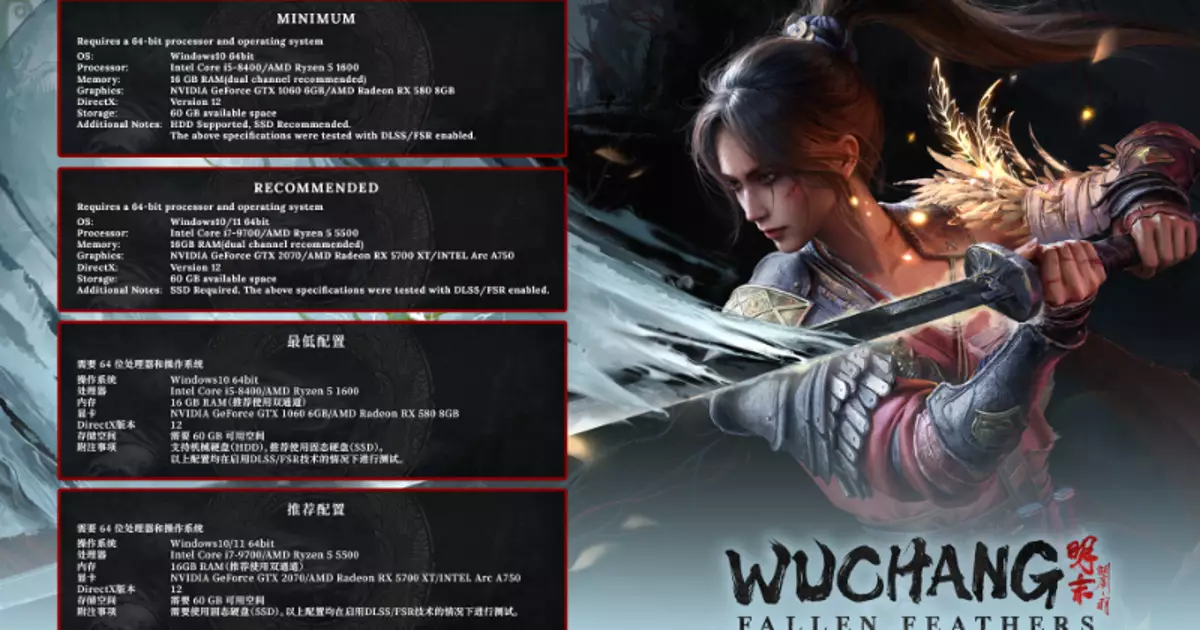In an industry where stunning visuals often demand the latest hardware, Wuchang: Fallen Feathers surprises with its surprisingly accessible system requirements. Offering a compelling blend of myth, mystique, and fierce combat, the game invites players to step into an ancient Chinese universe laden with supernatural dangers, without necessitating a rig top-tier enough to run the latest AAA blockbuster. Requiring only an Intel Core i5-8400 or AMD Ryzen 5 1600 alongside a GeForce GTX 1060 or Radeon RX 580, it positions itself as an approachable choice for dedicated gamers who still crave high-octane action and atmospheric storytelling. The inclusion of 16GB RAM and 60GB SSD storage further underscores this balanced approach—allowing a significant player base to experience a richly crafted world without the obsession with ultra-high settings. This pragmatic approach might prove pivotal for the game’s success, dismantling the myth that deeply immersive ARPGs must come with prohibitive hardware costs.
A Reimagined Mythical Realm: The Game’s Unique Setting and Its Connection to Bloodborne
Much of Wuchang’s intrigue stems from its atmospheric inspiration—initially dubbed the “Chinese Bloodborne” — and its stark, haunting world of Shu. Unlike the Gothic horror aesthetic of From Software’s classic, this universe is rooted in Chinese history, folklore, and a terrifying disease—the Feathering—that transforms inhabitants into bird-like monsters. Despite visual tweaks to make Shu feel less redolent of Yharnam, the core essence remains: a city besieged by a monstrous plague that alters its very fabric. Developer Leenzee seems intent on creating a nuanced balance—adding enough horror and challenge to satisfy fans of the soulslike genre while infusing it with cultural authenticity. This setting isn’t merely a backdrop, but a living, breathing entity where your choices influence the narrative arc, leading to multiple endings—an acknowledgment that player agency remains central to the game’s purpose.
Revving the Combat Engine and the Significance of Choice
What sets Wuchang apart from other titles in its category is its focus on visceral, upgradeable combat mechanics. The game introduces “Red Mercury”—a mysterious resource used to unlock new techniques and enhance weapons—promising a flexible, player-driven approach to battle. The ability to customize and strengthen your arsenal allows for varied playstyles, emphasizing strategic gameplay and mastery. The narrative depth is equally compelling; as you unravel Wuchang’s past, your decisions influence who survives, who betrays, and ultimately, what kind of hero—or antihero—you become. Multiple endings ensure that your journey remains personal, with each choice sculpting a unique legacy. This conceptual depth signals that Wuchang isn’t just another hack-and-slash affair but a thoughtfully crafted adventure that values storytelling as much as challenge.
The Technical Cornerstone: System Requirements and Advances in Graphics Technology
The game’s system requirements highlight an emerging trend—games that leverage advances like DLSS 4 technology for optimized performance. The mention of RTX 2070 or AMD Radeon RX 5700 XT graphics cards, alongside the requirement for an SSD on the recommended specs, suggests a focus on delivering both visual fidelity and smooth gameplay. DLSS (Deep Learning Super Sampling) can dramatically improve frame rates while maintaining crisp visuals, proving that sophisticated technology does not necessarily equate to exclusivity. This democratizes high-quality gaming, allowing players with mid-range hardware to experience cutting-edge effects. As someone deeply embedded in hardware analysis, I see this as a positive move towards inclusivity—removing the barrier of costly upgrades and fostering a broader gaming community eager for new experiences.
A Feast for the Imagination: Crafting a World of Mythical Beasts and Heroic Choices
Even beyond the impressive technical specifications, Wuchang’s thematic core offers a tantalizing prospect: what if we transformed into bird monsters? This whimsically dark idea reveals the game’s playful yet intense nature—merging mythological concepts with brutal combat. The potential for players to choose their path among various monstrous forms, each with unique abilities, adds a layer of personalization and strategic depth. The narrative’s emphasis on secrets, alliances, and choices echoes a broader philosophical question about identity and destiny—amplified by the game’s design to accommodate multiple endings. Here, Wuchang’s appeal extends beyond mere action; it becomes an exploration of self and morality, set against a backdrop of cultural mythology reimagined through the lens of modern game design.
Wuchang: Fallen Feathers positions itself as a thought-provoking, visually engaging, and mechanically satisfying addition to the ARPG landscape. Its clever balance of accessible hardware demands, cultural reinterpretation, narrative depth, and technological sophistication suggests that it might redefine expectations for what a mid-tier game can achieve. Far from just another action game, it promises to be a vibrant, challenging journey worth embarking upon.

